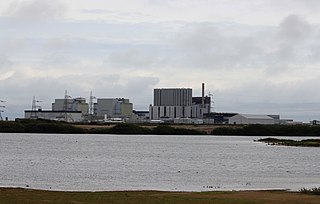
The Dungeness nuclear power stations are a pair of non-operational nuclear power stations located on the Dungeness headland in the south of Kent, England.
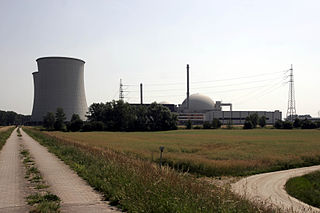
The Biblis Nuclear Power Plant is in the South Hessian municipality of Biblis and consists of two units: unit A with a gross output of 1200 megawatts and unit B with a gross output of 1300 megawatts. Both units are pressurized water reactors. The operator of this power plant is the German RWE Power AG, an electrical utility based in Essen. Unit A began operation on July 16, 1974, and entered commercial service on August 25, 1974; unit B reached criticality on March 25, 1976. Both units now are shut down definitely for political reasons (Atomausstieg).
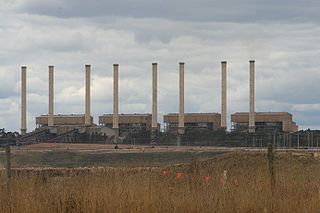
The Hazelwood Power Station was a decommissioned brown coal-fuelled thermal power station located in the Latrobe Valley of Victoria, Australia. Built between 1964 and 1971, the 1,600-megawatt-capacity power station was made up of eight 200MW units, and supplied up to 25% of Victoria's base load electricity and more than 5% of Australia's total electricity demand. It was a 'subcritical' pulverized coal-fired boiler. The station was listed as the least carbon efficient power station in the OECD in a 2005 report by WWF Australia, making it one of the most polluting power stations in the world. At 1.56 tonnes of CO2 for each megawatt hour of electricity, it was 50% more polluting than the average black coal power station in New South Wales or Queensland. Hazelwood emitted 14% of Victoria's annual greenhouse gas emissions and 3% of Australia's greenhouse gas emissions.

Jänschwalde Power Station is located near the village of Jänschwalde in Brandenburg on the German-Polish border. The lignite-fired power station has an installed capacity of 3,000 megawatts and consists of six 500 MW units. It is the third-largest brown coal power plant in operation in Germany and is currently owned by EPH, who took over its ownership from Vattenfall in 2016.
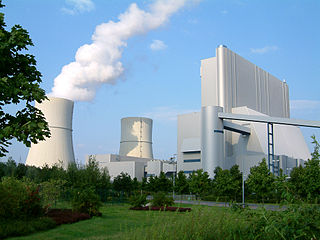
Black Pump power station is a modern lignite–fired power station in the Black Pump district in Spremberg, Germany, consisting of 2 × 800 megawatts (MW) units. Built by Siemens, the current plant came into service in 1997–1998. On 30 September 2016, Vattenfall sold the power station to the Czech energy group EPH and its financial partner PPF Investments. The cooling towers are 161 metres high and have an observation deck on top.

Aberthaw Power Station refers to two decommissioned coal-fired and co-fired biomass power stations on the coast of South Wales, near Barry in the Vale of Glamorgan. They were located at Limpert Bay, near the villages of Gileston and West Aberthaw. The most recent power station on the site, Aberthaw B Power Station, co-fired biomass and as of 2008 had a generating capacity of 1,560 megawatts (MW). The power station closed on 31 March 2020.

Buschhaus Power Station is a lignite-fired power station near Helmstedt in Lower Saxony, Germany. It is operated by Helmstedter Revier GmbH, a subsidiary company of MIBRAG. Until end of 2013, the power station was owned by E.ON.

Scholven Power Station is a coal-fired power plant in Gelsenkirchen, Germany. With an installed capacity of 2,126 megawatts, it is one of the largest power stations in Europe. It is owned by Uniper.

Lippendorf Power Station is a lignite-fired power station in Lippendorf, which is located in the municipality of Neukieritzsch, near Leipzig in Saxony, Germany. The power plant is owned and operated by Vattenfall Europe. It has a heating capacity of 330 MWt.

Boxberg Power Station is a lignite-fired power station with three units at Boxberg, near Weißwasser, Saxony, Eastern Germany. Since the late 1990s, it has a capacity of 1,900 MW.

Niederaussem Power Station is a lignite-fired power station in the Bergheim Niederaussem/Rhein Erft circle, owned by RWE. It consisted of nine units, which were built between 1963 and 2003. It is the largest lignite coal power plant in operation in Germany, with total net capacity of 2,220 MW. The plant is estimated to have been one of the ten most carbon-polluting coal-fired power plants in the world in 2018, at 27.2 million tons of carbon dioxide, and its emissions intensity is estimated to be 45.1% higher relative to the average for all fossil-fueled plants in Germany. According to the study Dirty Thirty, issued in 2007 by the WWF, Niederaussem Power Station is the second-worst power station in Europe in terms of mercury emissions due to the use of lignite.

The Sizewell nuclear site consists of two nuclear power stations, one of which is still operational, located near the small fishing village of Sizewell in Suffolk, England. Sizewell A, with two Magnox reactors, is now in the process of being decommissioned. Sizewell B has a single pressurised water reactor (PWR) and is the UK's newest nuclear power station. A third power station, to consist of twin EPR reactors, is planned to be built as Sizewell C.

Oldbury nuclear power station is a Magnox nuclear power station undergoing decommissioning. It is located on the south bank of the River Severn close to the village of Oldbury-on-Severn in South Gloucestershire, England. The ongoing decommissioning process is managed by Magnox Ltd, a subsidiary of the Nuclear Decommissioning Authority (NDA).
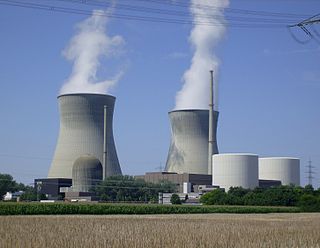
The Gundremmingen Nuclear Power Plant was a nuclear power station in Germany. It was located in Gundremmingen, district of Günzburg, Bavaria. It was operated by Kernkraftwerk Gundremmingen GmbH, a joint operation of RWE Power AG (75%) and PreussenElektra (25%). Unit B was shut down at the end of 2017. Unit C, the last boiling water reactor in Germany, was shut down on New Year's Eve 2021, as part of the German nuclear phase out. However, Gundremmingen unit C as well as the other two German nuclear reactors shut down that day remain capable of restarting operations as of March 2022. In November 1975, Unit A was the site of the first fatal accident in a nuclear power plant and subsequently of a major incident resulting in a total loss in 1977.

The Tilbury power stations were two thermal power stations on the north bank of the River Thames at Tilbury in Essex. The 360 MW dual coal- and oil-fired Tilbury A Power Station operated from 1956 until 1981 when it was mothballed, prior to demolition in 1999. The 1,428 MW Tilbury B Power Station operated between 1968 and 2013 and was fueled by coal, as well as co-firing with oil and, from 2011, biomass. Tilbury B was demolished in 2016–19. Since 2013 three other power stations have been proposed or constructed in Tilbury.

Neurath Power Station is a lignite-fired power station at Neurath in Grevenbroich, North Rhine-Westphalia, Germany. It is located to the south of Grevenbroich, and it borders the municipalities of Rommerskirchen and Bedburg. The power station consists of seven units and it is owned by RWE. It was named as the second biggest single polluter for carbon dioxide emissions in the European Union in 2019 by the EU's Transport and Environment Group, as well as the 102nd biggest polluting asset globally by Climate TRACE.

Mátra Power Plant, is a lignite fired power plant majority owned by MVM, the Hungarian state owned power company since 2019. It is located in the valley of the Mátra mountains, in Hungary. It has an installed electric power output of 950 MW, however, one 200 MW generator has been on permanent hiatus since January 2021. According to the latest government energy strategy, most of the existing lignite-fuelled units will be shut down in 2025, and a new 500 MW gas-fired unit will be added as well as up to 400 MW in solar power.

Neyveli Thermal Power Station is a set of power plant situated near lignite mines of Neyveli. It consists of three distinct units capable of producing 420 MW, 1,970 MW and 1000 MW respectively including their expansion units. It is operated by NLC. The total installed capacity of this station is 3390 MW as of April 2021.

NTPC, Barauni Or Barauni Thermal Power Station is an existing 720 megawatt coal-fired power station earlier owned by Bihar State Electricity Board (BSEB)and currently by NTPC Limited. The power station is located at Barauni in Begusarai district, Bihar, India. Barauni thermal power station in Bihar came into existence in association with the Russian collaboration and came into operation in the year 1962. Bihar Government was mulling over the idea to hand over Barauni Thermal Power Station to NTPC Limited. On 17 April 2018, Bihar state cabinet, headed by chief minister Nitish Kumar, gave its nod to handing over of Barauni Thermal Power Station to National Thermal Power Corporation. On 15 May 2018, Bihar Government signed a memorandum of understanding (MoU) to hand over the thermal plant to National Thermal Power Corporation for a 33- years lease. East Central Railway will provide uninterrupted supply of coal to thermal power station. NTPC completed the acquisition of 720 MW Barauni thermal power plant with effect from 15 December 2018. The units of Barauni power station will be progressively put under commercial operation.

The Rheinisches Braunkohlerevier, often called the Rhenish mining area, is a lignite mining area or district in the Cologne Bay, on the northwestern edge of the Rhenish Slate Mountains. The mining of lignite using the open pit method has had a significant impact on the landscape here and led to the formation of several important industrial sites. The area includes the Zülpicher and Jülicher Börde, the Erft lowlands and the Ville, making it the largest lignite mining area in Europe. To a lesser extent clay, silica sand and loess are mined here. The area is the only active lignite mining area in what was West Germany during German partition and contains the mines with the largest surface area, greatest depth, and biggest annual output of coal.






















